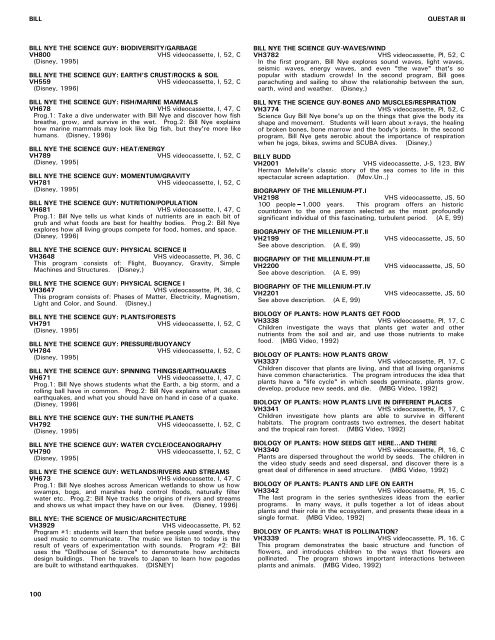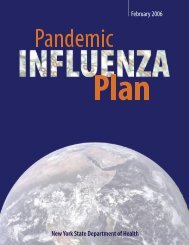QUESTAR III SUBJECT/TITLE INDEX P ART & MUSIC: BAROQUE ...
QUESTAR III SUBJECT/TITLE INDEX P ART & MUSIC: BAROQUE ...
QUESTAR III SUBJECT/TITLE INDEX P ART & MUSIC: BAROQUE ...
Create successful ePaper yourself
Turn your PDF publications into a flip-book with our unique Google optimized e-Paper software.
BILL<br />
<strong>QUESTAR</strong> <strong>III</strong><br />
BILL NYE THE SCIENCE GUY: BIODIVERSITY/GARBAGE<br />
BILL NYE THE SCIENCE GUY-WAVES/WIND<br />
VH800 VHS videocassette, I, 52, C VH3782 VHS videocassette, PI, 52, C<br />
(Disney, 1995)<br />
In the first program, Bill Nye explores sound waves, light waves,<br />
seismic waves, energy waves, and even "the wave" that's so<br />
BILL NYE THE SCIENCE GUY: E<strong>ART</strong>H'S CRUST/ROCKS & SOIL<br />
popular with stadium crowds! In the second program, Bill goes<br />
VH559 VHS videocassette, I, 52, C parachuting and sailing to show the relationship between the sun,<br />
(Disney, 1996) earth, wind and weather. (Disney,)<br />
BILL NYE THE SCIENCE GUY: FISH/MARINE MAMMALS<br />
BILL NYE THE SCIENCE GUY-BONES AND MUSCLES/RESPIRATION<br />
VH678 VHS videocassette, I, 47, C VH3774 VHS videocassette, PI, 52, C<br />
Prog.1: Take a dive underwater with Bill Nye and discover how fish Science Guy Bill Nye bone's up on the things that give the body its<br />
breathe, grow, and survive in the wet. Prog.2: Bill Nye explains shape and movement. Students will learn about x-rays, the healing<br />
how marine mammals may look like big fish, but they're more like of broken bones, bone marrow and the body's joints. In the second<br />
humans. (Disney, 1996) program, Bill Nye gets aerobic about the importance of respiration<br />
when he jogs, bikes, swims and SCUBA dives. (Disney,)<br />
BILL NYE THE SCIENCE GUY: HEAT/ENERGY<br />
VH789 VHS videocassette, I, 52, C BILLY BUDD<br />
(Disney, 1995) VH2001 VHS videocassette, J-S, 123, BW<br />
Herman Melville's classic story of the sea comes to life in this<br />
BILL NYE THE SCIENCE GUY: MOMENTUM/GRAVITY spectacular screen adaptation. (Mov.Un.,)<br />
VH781<br />
VHS videocassette, I, 52, C<br />
(Disney, 1995)<br />
BIOGRAPHY OF THE MILLENIUM-PT.I<br />
VH2198 VHS videocassette, JS, 50<br />
BILL NYE THE SCIENCE GUY: NUTRITION/POPULATION 100 people−1,000 years. This program offers an historic<br />
VH681 VHS videocassette, I, 47, C countdown to the one person selected as the most profoundly<br />
Prog.1: Bill Nye tells us what kinds of nutrients are in each bit of significant individual of this fascinating, turbulent period. (A E, 99)<br />
grub and what foods are best for healthy bodies. Prog.2: Bill Nye<br />
explores how all living groups compete for food, homes, and space. BIOGRAPHY OF THE MILLENIUM-PT.II<br />
(Disney, 1996) VH2199 VHS videocassette, JS, 50<br />
See above description. (A E, 99)<br />
BILL NYE THE SCIENCE GUY: PHYSICAL SCIENCE II<br />
VH3648<br />
VHS videocassette, PI, 36, C<br />
BIOGRAPHY OF THE MILLENIUM-PT.<strong>III</strong><br />
This program consists of: Flight, Buoyancy, Gravity, Simple<br />
VH2200 VHS videocassette, JS, 50<br />
Machines and Structures. (Disney,)<br />
See above description. (A E, 99)<br />
BILL NYE THE SCIENCE GUY: PHYSICAL SCIENCE I<br />
VH3647<br />
VHS videocassette, PI, 36, C<br />
This program consists of: Phases of Matter, Electricity, Magnetism,<br />
Light and Color, and Sound. (Disney,)<br />
BILL NYE THE SCIENCE GUY: PLANTS/FORESTS<br />
VH791<br />
VHS videocassette, I, 52, C<br />
(Disney, 1995)<br />
BILL NYE THE SCIENCE GUY: PRESSURE/BUOYANCY<br />
VH784<br />
VHS videocassette, I, 52, C<br />
(Disney, 1995)<br />
BILL NYE THE SCIENCE GUY: SPINNING THINGS/E<strong>ART</strong>HQUAKES<br />
VH671<br />
VHS videocassette, I, 47, C<br />
Prog.1: Bill Nye shows students what the Earth, a big storm, and a<br />
rolling ball have in common. Prog.2: Bill Nye explains what causes<br />
earthquakes, and what you should have on hand in case of a quake.<br />
(Disney, 1996)<br />
BILL NYE THE SCIENCE GUY: THE SUN/THE PLANETS<br />
VH792<br />
VHS videocassette, I, 52, C<br />
(Disney, 1995)<br />
BIOGRAPHY OF THE MILLENIUM-PT.IV<br />
VH2201 VHS videocassette, JS, 50<br />
See above description. (A E, 99)<br />
BIOLOGY OF PLANTS: HOW PLANTS GET FOOD<br />
VH3338<br />
VHS videocassette, PI, 17, C<br />
Children investigate the ways that plants get water and other<br />
nutrients from the soil and air, and use those nutrients to make<br />
food. (MBG Video, 1992)<br />
BIOLOGY OF PLANTS: HOW PLANTS GROW<br />
VH3337<br />
VHS videocassette, PI, 17, C<br />
Children discover that plants are living, and that all living organisms<br />
have common characteristics. The program introduces the idea that<br />
plants have a "life cycle" in which seeds germinate, plants grow,<br />
develop, produce new seeds, and die. (MBG Video, 1992)<br />
BIOLOGY OF PLANTS: HOW PLANTS LIVE IN DIFFERENT PLACES<br />
VH3341<br />
VHS videocassette, PI, 17, C<br />
Children investigate how plants are able to survive in different<br />
habitats. The program contrasts two extremes, the desert habitat<br />
and the tropical rain forest. (MBG Video, 1992)<br />
BILL NYE THE SCIENCE GUY: WATER CYCLE/OCEANOGRAPHY BIOLOGY OF PLANTS: HOW SEEDS GET HERE...AND THERE<br />
VH790<br />
VHS videocassette, I, 52, C VH3340<br />
VHS videocassette, PI, 16, C<br />
(Disney, 1995)<br />
Plants are dispersed throughout the world by seeds. The children in<br />
the video study seeds and seed dispersal, and discover there is a<br />
BILL NYE THE SCIENCE GUY: WETLANDS/RIVERS AND STREAMS great deal of difference in seed structure. (MBG Video, 1992)<br />
VH673<br />
VHS videocassette, I, 47, C<br />
Prog.1: Bill Nye sloshes across American wetlands to show us how BIOLOGY OF PLANTS: PLANTS AND LIFE ON E<strong>ART</strong>H<br />
swamps, bogs, and marshes help control floods, naturally filter VH3342<br />
VHS videocassette, PI, 15, C<br />
water etc. Prog.2: Bill Nye tracks the origins of rivers and streams The last program in the series synthesizes ideas from the earlier<br />
and shows us what impact they have on our lives. (Disney, 1996) programs. In many ways, it pulls together a lot of ideas about<br />
plants and their role in the ecosystem, and presents these ideas in a<br />
BILL NYE: THE SCIENCE OF <strong>MUSIC</strong>/ARCHITECTURE<br />
single format. (MBG Video, 1992)<br />
VH3929 VHS videocassette, PI, 52<br />
Program #1: students will learn that before people used words, they BIOLOGY OF PLANTS: WHAT IS POLLINATION?<br />
used music to communicate. The music we listen to today is the VH3339<br />
VHS videocassette, PI, 16, C<br />
result of years of experimentation with sounds. Program #2: Bill This program demonstrates the basic structure and function of<br />
uses the "Dollhouse of Science" to demonstrate how architects flowers, and introduces children to the ways that flowers are<br />
design buildings. Then he travels to Japan to learn how pagodas pollinated. The program shows important interactions between<br />
are built to withstand earthquakes. (DISNEY) plants and animals. (MBG Video, 1992)<br />
100

















